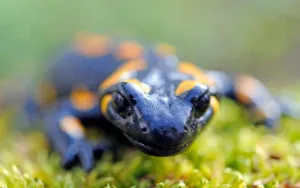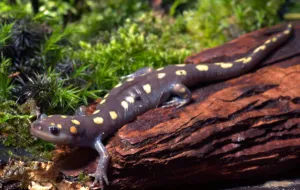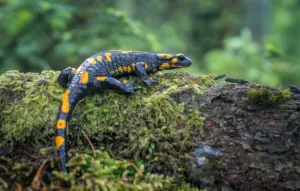
Table of Contents
Scientific Classification
- Kingdom: Animalia
- Phylum: Chordata
- Class: Amphibia
- Order: Urodela
- Family: Ambystomatidae
- Genus: Ambystoma
- Species: Ambystoma maculatum
Quick Overview
The Spotted Salamander (Ambystoma maculatum) is a captivating amphibian known for its distinctive appearance and fascinating life cycle. Native to eastern North America, these salamanders are often found in deciduous woodlands and are recognized for their vibrant yellow spots against a dark background.
Fast Facts
- Scientific Name: Ambystoma maculatum
- Lifespan: Up to 20 years in the wild
- Average Length: 6 to 9 inches
- Diet: Carnivorous, preying on insects, worms, and small invertebrates
- Habitat: Deciduous woodlands, breeding in ephemeral pools
Did you know?
Spotted Salamanders are known for their annual migration to breeding ponds, often covering significant distances to reach these essential breeding grounds.
Appearance
These salamanders feature a striking black or dark brown body adorned with vibrant yellow spots. Their stout bodies and smooth skin contribute to their visually appealing appearance.
Size and Weight
Adult Spotted Salamanders typically measure between 6 to 9 inches in length. Their robust bodies are well-adapted to a terrestrial lifestyle.
Temperament and Behavior
Spotted Salamanders are primarily nocturnal, seeking refuge under leaf litter or logs during the day. They are known for their secretive nature and may remain hidden for much of the year.
Fun Fact
Spotted Salamanders possess specialized glands on their backs that secrete a toxic substance, acting as a deterrent against predators.
Habitat and Distribution
These salamanders are found in deciduous woodlands throughout eastern North America, ranging from southern Canada to the Gulf of Mexico. Breeding habitats include temporary pools formed by melting snow or rain.

Care Guide
While not commonly kept as pets, if considering Spotted Salamanders in captivity, providing a habitat that mimics their natural woodland environment with proper moisture levels is essential.
Diet and Nutrition
In the wild, Spotted Salamanders feed on a diet of insects, worms, and various small invertebrates. In captivity, their diet should reflect these preferences for optimal health.
Health and Wellness
Maintaining appropriate humidity levels and a clean environment is crucial for the well-being of Spotted Salamanders. Regular veterinary check-ups are advisable.
Reproduction
Breeding occurs during the spring, and females deposit gelatinous egg masses in breeding ponds. The larvae undergo metamorphosis, eventually transforming into terrestrial adults.
Conservation Status
While not currently classified as endangered, Spotted Salamanders face threats such as habitat loss and fragmentation. Conservation efforts focus on preserving their woodland habitats.
Fun Fact
Spotted Salamanders are an essential part of the ecosystem, contributing to insect control and serving as indicators of environmental health due to their sensitivity to habitat changes.
Photo Gallery




Related Profiles
Share This Profile
Fascinating Facts About Spotted Salamanders
- Habitat Diversity: Spotted Salamanders display a preference for diverse habitats, occupying woodlands, meadows, and forests, contributing to the biodiversity of these ecosystems.
- Intricate Color Patterns: These salamanders exhibit a fascinating array of color patterns, providing camouflage in their natural surroundings and making them a subject of interest for researchers studying their varied markings.
- Mating Rituals: Spotted Salamanders engage in intricate courtship rituals during the breeding season, involving elaborate dance-like movements. These behaviors play a crucial role in attracting mates and ensuring successful reproduction.
- Enchi Ball Python: A Unique and Stunning Morph of Python regius - March 27, 2025
- Emerald Tree Monitor: The Enigmatic Green Guardian of the Rainforest - March 26, 2025
- The Egyptian Cobra (Naja haje): A Fascinating Serpent - March 25, 2025
